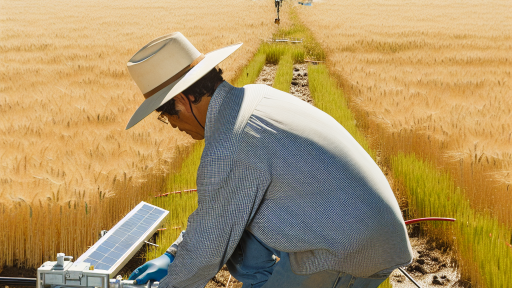Introduction to Climate-Smart Farming
Definition and Importance
Climate-smart farming is an innovative approach to agriculture.
It aims to increase productivity while building resilience to climate change.
This approach focuses on sustainable practices that benefit both farmers and the environment.
Farmers face numerous challenges due to climate change impacts.
These include extreme weather, shifting climatic conditions, and soil degradation.
Therefore, embracing climate-smart strategies is crucial for future farming.
Additionally, climate-smart farming enhances food security globally.
It ensures that agricultural systems can withstand unpredictable weather patterns.
Moreover, this method promotes efficient use of resources such as water and energy.
Consequently, farmers can reduce greenhouse gas emissions from their practices.
Overall, climate-smart farming represents a vital shift towards sustainability.
It allows farmers to adapt to ongoing changes while continuing to produce food effectively.
Implementing these practices can lead to substantial economic benefits.
As a result, farmers can achieve better yields and improve their livelihoods.
Climate-smart farming is essential in today’s agricultural landscape.
Transform Your Agribusiness
Unlock your farm's potential with expert advice tailored to your needs. Get actionable steps that drive real results.
Get StartedThis approach addresses urgent environmental issues while supporting farming communities.
Assessing Local Climate Impacts
Understanding Climate Variability
Local climate impacts vary from region to region.
Farmers must recognize the specific climatic changes in their areas.
Understanding these changes helps inform effective farming practices.
Additionally, it supports the adaptation of crops to local conditions.
Tools for Climate Assessment
Farmers can use various tools to assess climate impacts.
Weather monitoring systems provide real-time data on environmental conditions.
Climate models predict future weather patterns based on current data.
Remote sensing technologies help analyze land-use changes and vegetation health.
Moreover, soil moisture sensors can monitor soil conditions accurately.
Community Resources and Data Sharing
Local agricultural extension offices offer valuable resources.
Farmers can collaborate with universities for climate research initiatives.
Community workshops promote data sharing among farmers.
Networking with other local farmers fosters knowledge exchange.
Online platforms can facilitate discussions on climate-smart practices.
Adapting Farming Practices
Adapting farming practices is crucial for mitigating climate impacts.
Crop rotation enriches soil health and reduces pests.
Drought-resistant crop varieties are essential in arid regions.
Implementing cover crops can improve soil structure and fertility.
Additionally, precision agriculture techniques optimize resource use.
Monitoring and Evaluation
Regular monitoring of climate adaptation efforts is vital.
Farmers should track yields and environmental impacts continuously.
Evaluating results helps refine practices for better outcomes.
Moreover, documentation of successful adaptations can inspire others.
Showcase Your Farming Business
Publish your professional farming services profile on our blog for a one-time fee of $200 and reach a dedicated audience of farmers and agribusiness owners.
Publish Your ProfileSharing experiences creates a collective approach to climate-smart farming.
Cost-Effective Practices: Crop Rotation and Diversity
Benefits of Crop Rotation
Crop rotation enhances soil health and fertility.
This practice disrupts pest cycles and reduces disease risks.
Additionally, it minimizes the need for chemical fertilizers.
Farmers often see increased yields over time when rotating crops.
Implementing Crop Rotation
Start by selecting a variety of crops suitable for your region.
Plan the sequence of planting to maximize benefits.
Consider legumes to improve nitrogen levels in the soil.
Track your crop performance to refine your rotation strategy.
Diversifying Crop Types
Diversity in crops leads to a more resilient farming system.
Mixing plants reduces reliance on a single crop type.
This approach helps protect against market fluctuations.
Incorporate cover crops to improve soil structure and health.
Best Practices for Crop Diversity
Choose complementary crops that thrive together.
Utilize intercropping to maximize space and resources.
Monitor plant interactions to optimize growth conditions.
Engage with local agricultural agencies for advice on diversity.
Economic Advantages
Cost savings arise from reduced pesticide and fertilizer use.
Enhanced biodiversity can also attract beneficial insects.
Farmers often enjoy access to new markets due to diverse crops.
In the long run, this strategy can lead to improved profitability.
You Might Also Like: Livestock Farming: Reducing Greenhouse Gas Output
Water Management Solutions
Rainwater Harvesting
Rainwater harvesting captures and stores rainwater for agricultural use.
This technique reduces dependence on conventional water sources.
Farmers can install collection systems on roofs or other surfaces.
These systems channel water into storage tanks or barrels.
Storage tanks should be covered to prevent evaporation and contamination.
Harvested rainwater can irrigate crops during dry spells.
This method also helps in flood mitigation by reducing runoff.
Farmers can use this system effectively in regions with seasonal rains.
Additionally, local governments often support sustainable initiatives.
Incentives may lower installation costs for farmers.
Drip Irrigation
Drip irrigation delivers water directly to plant roots.
This method minimizes water waste and increases efficiency.
Farmers can achieve significant savings on water usage.
Drip systems are customizable to suit different crops and fields.
The installation usually requires mainline pipes and tubing.
Emitters release small amounts of water, promoting healthy growth.
Farmers can automate these systems to optimize usage.
Furthermore, drip irrigation can improve soil health over time.
Showcase Your Farming Business
Publish your professional farming services profile on our blog for a one-time fee of $200 and reach a dedicated audience of farmers and agribusiness owners.
Publish Your ProfileLess surface evaporation occurs compared to traditional irrigation methods.
This technique enhances crop yields while conserving resources.
Cost Considerations
Implementing these water management solutions can be affordable.
Initial costs may vary based on scale and technology.
However, long-term savings often offset initial investments.
Farmers should evaluate local resource availability when planning.
Community workshops can provide valuable information and support.
Public-private partnerships can enhance funding opportunities.
With careful planning, farmers can achieve sustainable water management.
Explore Further: Climate-Smart Livestock Management for Farmers
Soil Health Improvement
Importance of Soil Health
Soil health is vital for successful farming.
Healthy soil supports robust crop growth and development.
Moreover, it contributes to environmental resilience.
Techniques for Sustainable Soil Management
Farmers can enhance soil quality through various practices.
These practices focus on maintaining soil structure.
Additionally, they improve soil fertility and microbial activity.
Crop Rotation
Crop rotation diversifies plant species on the same land.
This practice helps prevent pest and disease buildup.
Furthermore, it enhances soil nutrients over time.
Cover Cropping
Cover crops protect the soil from erosion.
They also improve soil organic matter content.
Choosing suitable cover crops boosts soil health.
Reduced Tillage
Reduced tillage minimizes soil disturbance.
This method preserves soil structure and microbial life.
As a result, it enhances moisture retention.
Utilizing Organic Amendments
Organic amendments enrich the soil with nutrients.
Composting is an effective method to recycle waste.
This process results in nutrient-dense material for the soil.
Application of Biochar
Biochar enhances soil fertility and carbon storage.
This amendment improves water retention in the soil.
Utilizing biochar can lead to increased crop yields.
Mulching Techniques
Mulching conserves soil moisture and suppresses weeds.
It also regulates soil temperature throughout the year.
Choosing organic mulch provides additional nutrients.
Monitoring Soil Health
Regular soil testing helps assess nutrient levels.
This practice informs necessary amendments and adjustments.
Ultimately, maintaining soil health requires ongoing effort.
Delve into the Subject: Rainwater Harvesting Tips for Enhanced Farm Water Use
Utilizing Technology: Affordable Tools for Monitoring and Data Collection
Importance of Technology in Farming
Modern farming relies heavily on technology for success.
Technology enhances efficiency and reduces costs.
Showcase Your Farming Business
Publish your professional farming services profile on our blog for a one-time fee of $200 and reach a dedicated audience of farmers and agribusiness owners.
Publish Your ProfileAdditionally, it helps farmers make informed decisions.
Accessing Affordable Monitoring Tools
Farmers can access various affordable monitoring tools today.
Smartphone applications offer real-time weather updates.
These apps help track crop health and productivity.
Moreover, they assist in pest and disease management.
Implementing Data Collection Techniques
Data collection techniques are essential for effective farming.
Farmers can use soil moisture sensors to optimize irrigation.
These sensors provide accurate data for better water management.
Furthermore, yield monitoring systems track harvest performance.
Low-Cost Precision Agriculture Solutions
Precision agriculture tools are becoming more affordable.
Drone technology offers cost-effective aerial monitoring options.
Farmers can assess crop conditions from above.
This technology aids in identifying areas needing attention.
Educational Resources and Training
Education is key to utilizing technology effectively.
Many organizations offer training on modern farming tools.
Farmers can attend workshops or online courses.
Additionally, local agricultural extension services provide support.
Collaborative Farming Practices
Collaboration can enhance technology access and usage.
Farmers can form cooperatives to share expensive tools.
This approach reduces individual costs and improves efficiency.
Furthermore, it fosters knowledge sharing within the community.
Gain More Insights: How to Adapt Crops for a Changing Climate

Community Engagement: Building Networks for Shared Resources and Knowledge
Understanding Community Engagement
Community engagement plays a vital role in climate-smart farming.
It fosters collaboration among farmers, researchers, and local organizations.
Furthermore, it helps share resources efficiently and effectively.
Creating Collaborative Networks
Farmers should prioritize creating collaborative networks.
Joining local associations strengthens community ties.
These networks enable the sharing of knowledge and experiences.
Additionally, they can facilitate access to essential resources.
Utilizing Technology for Communication
Leveraging technology enhances communication among community members.
Online platforms and social media can disseminate information rapidly.
Moreover, farmers can share best practices through virtual meetings.
This approach fosters teamwork and collective problem-solving.
Organizing Workshops and Training Sessions
Workshops can provide hands-on learning experiences.
They promote knowledge sharing on sustainable practices.
Additionally, training sessions can focus on new technologies.
This collaboration helps build resilience in farming communities.
Forming Partnerships for Resource Sharing
Forming partnerships can enhance resource sharing.
Farmers can collaborate with organizations for funding opportunities.
Community gardens often provide a platform for resource exchange.
Showcase Your Farming Business
Publish your professional farming services profile on our blog for a one-time fee of $200 and reach a dedicated audience of farmers and agribusiness owners.
Publish Your ProfileThese partnerships increase access to necessary supplies.
Promoting Local Market Initiatives
Engaging in local market initiatives can bolster community resilience.
Farmers should connect with local consumers directly.
Local venues allow producers to sell their goods fresh.
This creates a feedback loop that benefits both parties.
Measuring Impact and Success
It’s essential to measure the impact of community engagement efforts.
Surveys and feedback sessions can provide valuable insights.
Assessing success helps refine future initiatives.
Ultimately, continuous improvement is key to sustainability.
Case Studies: Successful Implementations of Cost-Effective Climate-Smart Practices
Community Supported Agriculture in Springfield
The Springfield community has embraced sustainable agriculture.
The local farmers have reduced input costs through collaborative efforts.
Members purchase shares upfront to support farms directly.
This model ensures farmers have the necessary funds at the beginning of the season.
Consequently, the risk of crop failure diminishes.
Moreover, the community enjoys fresh produce throughout the growing season.
Drip Irrigation in Rivera Farms
Rivera Farms implemented drip irrigation to conserve water.
This system delivers water directly to plant roots.
As a result, water usage decreased by 30% annually.
Additionally, crop yields increased due to more efficient water delivery.
The farmers observed less disease and pest pressure with this method.
This approach not only saves money but also enhances crop quality.
Agroforestry Practices in Green Valley
Green Valley adopted agroforestry to improve soil health and biodiversity.
Farmers integrated trees with their crops and livestock systems.
This strategy promotes nutrient recycling and reduces erosion.
Furthermore, it increases resilience to climate extremes.
We can see more diverse habitats attract beneficial insects.
Consequently, farmers face fewer crop-damaging pests.
Climate-Resilient Crop Rotation in Blue River
In Blue River, farmers started climate-resilient crop rotations.
This practice improves soil fertility and reduces pests.
Crops such as legumes add nitrogen back into the soil.
This results in lower fertilizer costs over time.
Farmers have reported higher yields and better resilience to drought conditions.
This method proves effective in managing local climate challenges.
Organic Mulching Techniques in Pinecrest
Pinecrest farmers adopted organic mulching to retain soil moisture.
Using biodegradable materials, they reduce weed growth and soil erosion.
This technique has significantly lowered water consumption.
Farmers appreciate the enhanced soil structure resulting from mulching.
Additionally, organic materials enrich the soil as they decompose.
This practice shows potential for widespread adoption in similar climates.
The Future of Farming in the Face of Climate Change
Importance of Climate-Smart Farming
Climate-smart farming is essential for sustainable agriculture.
Showcase Your Farming Business
Publish your professional farming services profile on our blog for a one-time fee of $200 and reach a dedicated audience of farmers and agribusiness owners.
Publish Your ProfileThis approach enhances resilience to climate variations.
It also improves agricultural productivity and food security.
Innovative Techniques for Adaptation
Farmers can use crop rotation to enhance soil health.
This method helps prevent pests and diseases effectively.
Additionally, agroforestry integrates trees with crops.
Such practices increase biodiversity on farms.
Using cover crops can mitigate soil erosion as well.
Economic Benefits of Adaptations
Cost-effective adaptations significantly reduce farming expenses.
Farmers often experience lower input costs through efficient practices.
By adopting integrated pest management, they decrease pesticide use.
This leads to healthier ecosystems and better crop yields.
Community Engagement and Support
Engaging local communities fosters shared knowledge and resources.
Cooperatives can provide financial assistance for adaptations.
This collaboration promotes sustainable practices across regions.
Technological Advancements
Leveraging technology enhances precision in farming practices.
Farmers can utilize data analytics for informed decision-making.
Drones and sensors help monitor crop health efficiently.
These technologies promote resource conservation, specifically water.
Policies Supporting Climate-Smart Farming
Government incentives encourage farmers to adopt sustainable practices.
Policies should prioritize funding for climate-smart initiatives.
Furthermore, education programs can help build awareness effectively.
Prospects for Future Farming
The future of farming hinges on adaptation and innovation.
Investing in technology will drive agricultural transformation.
Farmers who embrace sustainability will thrive in changing climates.
Ultimately, climate-smart practices will ensure food security for all.




